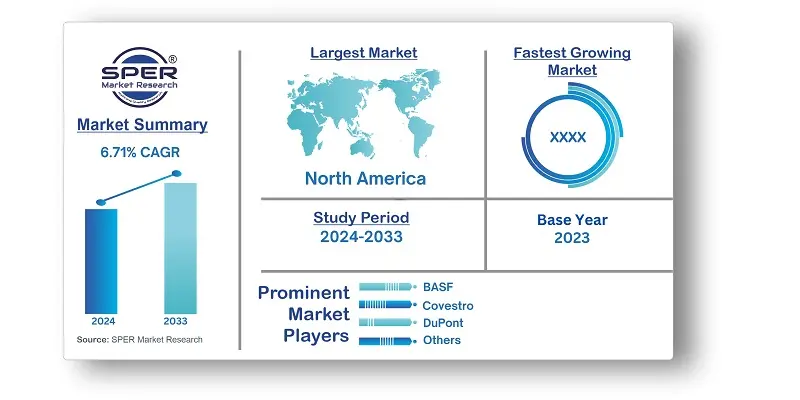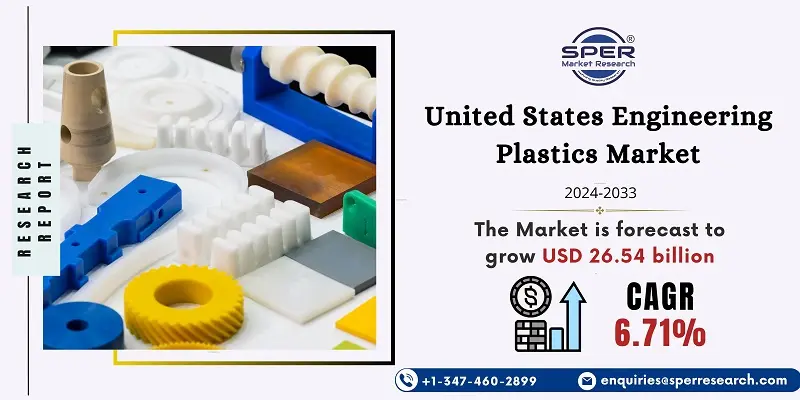
United States Engineering Plastics Market Trends, Share, Size, Scope, Revenue and Future Outlook
United States Engineering Plastics Market Growth, Size, Trend Analysis- By End User Industry, By Resin Type- Regional Outlook, Competitive Strategies and Segment Forecast to 2033
| Published: Oct-2024 | Report ID: CHEM24103 | Pages: 1 - 115 | Formats*: |
| Category : Chemical & Materials | |||
- February 2023; Makrolon 3638 polycarbonate was introduced by Covestro AG for use in healthcare and life sciences applications such as drug delivery devices, wellness and wearable devices, and single-use biopharmaceutical processing containers.
- November 2022; Celanese Corporation has finalized its acquisition of DuPont's Mobility and Materials ("M&M") business. This acquisition expanded the company's engineered thermoplastics product line by including well-known DuPont brands and intellectual property.


| Report Metric | Details |
| Market size available for years | 2020-2033 |
| Base year considered | 2023 |
| Forecast period | 2024-2033 |
| Segments covered | By End User industry, By Resin Type. |
| Regions covered | Midwest Region, Northeast Region, South Region, Southwest Region, West Region. |
| Companies Covered | BASF, Celanese Corporation, Covestro, DuPont, Eastman Chemical Company, LANXESS, Mitsubishi Engineering-Plastics Corporation, PolyOne Corporation, SABIC. |
- Automotive Manufacturers
- Aerospace Companies
- Electronics Manufacturers
- Medical Device Companies
- Consumer Goods Manufacturers
- Construction and Infrastructure Firms
| By End User Industry: | |
| By Resin Type: |
- United States Engineering Plastics Market Size (FY’2024-FY’2033)
- Overview of United States Engineering Plastics Market
- Segmentation of United States Engineering Plastics Market By End User Industry (Aerospace, Automotive, Packaging, Industrial and Machinery, Others)
- Segmentation of United States Engineering Plastics Market by Resin Type (Fluoropolymer, Polyimide, Polybutylene Terephthalate, Polyamide, Polycarbonate, Poly Ether ketone, Styrene Copolymers, Others)
- Statistical Snap of United States Engineering Plastics Market
- Expansion Analysis of United States Engineering Plastics Market
- Problems and Obstacles in United States Engineering Plastics Market
- Competitive Landscape in the United States Engineering Plastics Market
- Impact of COVID-19 and Demonetization on United States Engineering Plastics Market
- Details on Current Investment in United States Engineering Plastics Market
- Competitive Analysis of United States Engineering Plastics Market
- Prominent Players in the United States Engineering Plastics Market
- SWOT Analysis of United States Engineering Plastics Market
- United States Engineering Plastics Market Future Outlook and Projections (FY’2024-FY’2033)
- Recommendations from Analyst
1.1. Scope of the report1.2. Market segment analysis
2.1. Research data source
2.1.1. Secondary Data2.1.2. Primary Data2.1.3. SPERs internal database2.1.4. Premium insight from KOLs
2.2. Market size estimation
2.2.1. Top-down and Bottom-up approach
2.3. Data triangulation
4.1. Driver, Restraint, Opportunity and Challenges analysis
4.1.1. Drivers4.1.2. Restraints4.1.3. Opportunities4.1.4. Challenges
4.2. COVID-19 Impacts of the United States Engineering Plastics Market
5.1. SWOT Analysis
5.1.1. Strengths5.1.2. Weaknesses5.1.3. Opportunities5.1.4. Threats
5.2. PESTEL Analysis
5.2.1. Political Landscape5.2.2. Economic Landscape5.2.3. Social Landscape5.2.4. Technological Landscape5.2.5. Environmental Landscape5.2.6. Legal Landscape
5.3. PORTERs Five Forces
5.3.1. Bargaining power of suppliers5.3.2. Bargaining power of buyers5.3.3. Threat of Substitute5.3.4. Threat of new entrant5.3.5. Competitive rivalry
5.4. Heat Map Analysis
6.1. United States Engineering Plastics Market Manufacturing Base Distribution, Sales Area, Product Type6.2. Mergers & Acquisitions, Partnerships, Product Launch, and Collaboration in United States Engineering Plastics Market
7.1. United States Engineering Plastics Market Size, Share and Forecast, By End User Industry, 2020-20267.2. United States Engineering Plastics Market Size, Share and Forecast, By End User Industry, 2027-20337.3. Aerospace7.4. Automotive7.5. Packaging7.6. Industrial and Machinery7.7. Others
8.1. United States Engineering Plastics Market Size, Share and Forecast, By Resin Type, 2020-20268.2. United States Engineering Plastics Market Size, Share and Forecast, By Resin Type, 2027-20338.3. Fluoropolymer8.4. Polyimide8.5. Polybutylene Terephthalate8.6. Polyamide8.7. Polycarbonate8.8. Poly Ether ketone8.9. Styrene Copolymers8.10. Others
9.1. United States Engineering Plastics Market Size and Market Share
10.1. United States Engineering Plastics Market Size and Market Share By Region (2020-2026)10.2. United States Engineering Plastics Market Size and Market Share By Region (2027-2033)10.3. Midwest Region10.4. Northeast Region10.5. South Region10.6. Southwest Region10.7. West Region
11.1. BASF
11.1.1. Company details11.1.2. Financial outlook11.1.3. Product summary11.1.4. Recent developments
11.2. Celanese Corporation
11.2.1. Company details11.2.2. Financial outlook11.2.3. Product summary11.2.4. Recent developments
11.3. Covestro
11.3.1. Company details11.3.2. Financial outlook11.3.3. Product summary11.3.4. Recent developments
11.4. DuPont
11.4.1. Company details11.4.2. Financial outlook11.4.3. Product summary11.4.4. Recent developments
11.5. Eastman Chemical Company
11.5.1. Company details11.5.2. Financial outlook11.5.3. Product summary11.5.4. Recent developments
11.6. LANXESS
11.6.1. Company details11.6.2. Financial outlook11.6.3. Product summary11.6.4. Recent developments
11.7. Mitsubishi Engineering-Plastics Corporation
11.7.1. Company details11.7.2. Financial outlook11.7.3. Product summary11.7.4. Recent developments
11.8. PolyOne Corporation
11.8.1. Company details11.8.2. Financial outlook11.8.3. Product summary11.8.4. Recent developments
11.9. SABIC
11.9.1. Company details11.9.2. Financial outlook11.9.3. Product summary11.9.4. Recent developments
11.10. Others
SPER Market Research’s methodology uses great emphasis on primary research to ensure that the market intelligence insights are up to date, reliable and accurate. Primary interviews are done with players involved in each phase of a supply chain to analyze the market forecasting. The secondary research method is used to help you fully understand how the future markets and the spending patterns look likes.
The report is based on in-depth qualitative and quantitative analysis of the Product Market. The quantitative analysis involves the application of various projection and sampling techniques. The qualitative analysis involves primary interviews, surveys, and vendor briefings. The data gathered as a result of these processes are validated through experts opinion. Our research methodology entails an ideal mixture of primary and secondary initiatives.



Frequently Asked Questions About This Report
PLACE AN ORDER
Year End Discount
Sample Report
Pre-Purchase Inquiry
NEED CUSTOMIZATION?
Request CustomizationCALL OR EMAIL US
100% Secure Payment






Related Reports
Our Global Clients
Our data-driven insights have influenced the strategy of 200+ reputed companies across the globe.




















